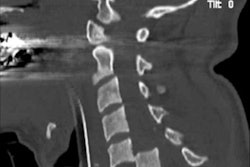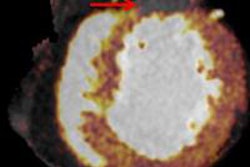
To use MRI or not to use MRI for cervical spine clearance after blunt traumatic injury? That is the question -- and remains so, according to a study published in European Radiology. Researchers found "significant heterogeneity" in the literature around MRI's use, and they emphasize that more research is needed.
The meta-analysis spanned multiple studies and numerous patients, zeroing in on the rate of unstable injuries missed on CT in blunt cervical spine trauma patients but detected by MRI. The U.S. research team, led by Drs. Ajay Malhotra and Xiao Wu from the radiology and biomedical imaging department at Yale University in New Haven, Connecticut, ultimately found the data are inconclusive when it comes to this topic (EurRadiol, 22 June 2016).
"The literature is very heterogeneous, and utility of MRI to detect unstable injury in patients with a negative noncontrast CT depends on many variables, most not well-defined currently," they noted. "Utility of MRI in blunt cervical spine injury, its timing, and its cost-effectiveness needs further study."
Why MRI?
Clearance of the cervical spine in blunt trauma patients with a normal noncontrast CT scan presents a challenge. Failure to recognize and immobilize an unstable injury can result in avoidable, secondary neurological deterioration and have medicolegal implications, according to the authors. However, routine immobilization with cervical collars also carries risks such as pressure ulcers, respiratory problems, and raised intracranial pressure.
Because of its contrast resolution, MRI continues to be recommended. To date, the research is contradictory, with some authors advocating MRI's use and others deeming CT alone sufficient. Malhotra and Wu sought to clear away the confusion by quantifying the rate of unstable injuries detected by MRI that were missed on CT and, thus, assess the utility of MRI in cervical spine clearance in blunt trauma patients.
"The heterogeneity in the literature is partly due to varying definitions of 'clinically significant' injury used to assess the utility of MRI," the researchers wrote. "The decision to have prolonged external immobilization or operative stabilization seems arbitrary and has not been clearly outlined, but has been used by previous studies to determine the role of MRI."
They performed a systematic search in the medical literature and screened for studies with unstable injuries detected on follow-up after a negative noncontrast CT, encompassing 23 studies and 5,286 patients. They included both obtunded and alert patients who had an initial negative cervical spine CT and subsequently performed subgroup analyses based on patients' mental status.
Because the primary aim of clearing the cervical spine in blunt trauma patients is to assess for instability, the researchers stuck to unstable injuries and the usefulness of MRI in evaluating them. In the end, the researchers whittled the studies down to five, finding 16 cases of unstable injury on follow-up MRI.
What they found
The meta-analysis demonstrated a 15.0% rate of abnormal findings overall on follow-up MRI in patients with a normal cervical spine CT scan, but the overall risk of detecting an unstable injury on follow-up was as low as 0.3% when weighted by size of patient population and 0.0029% when weighted to reduce the disproportionate contribution by smaller studies.
The reported incidence of abnormal findings in alert patients (0.72%) was higher than in obtunded patients (0.12%), but after weighting the pooled incidence in alert patients was lower, which is likely because the studies reporting unstable injuries in alert patients had smaller study populations, reported Malhotra and Wu.
"The true instability of cervical injuries remains unclear," they stated. Most studies that identified unstable injuries on MRI did not have clinical follow-up to document stability.
"Cervical collar use or surgery was done as follow-up, but that decision does not seem to have a direct correlation with evidence of unstable injury on imaging," they added."Also lacking in the literature is the follow-up to see if MRI spinal soft-tissue/ligamentous changes evolve over time and get better after cervical collar use and if it has any bearing on cervical instability."
The authors also found MRI has a high false-positive rate, and many of the MR findings do not correspond to instability on follow-up radiography.
"Based on our review, there are only a few reported cases in the literature of unstable injury detected on MRI and potentially missed on an initial CT," they concluded. "The actual incidence might even be lower if MRI is performed more liberally, since many of the studies may have had a selection bias as to which patients got an MRI."
The accuracy and reliability of MRI findings is difficult to determine based on existing literature but raises serious questions, they concluded.
The researchers are working on other projects surrounding this topic, Malhotra told AuntMinnieEurope.com. They have conducted a cost-effectiveness analysis that is currently under review with European Radiology and an institutional study they are in the process of writing up.



















